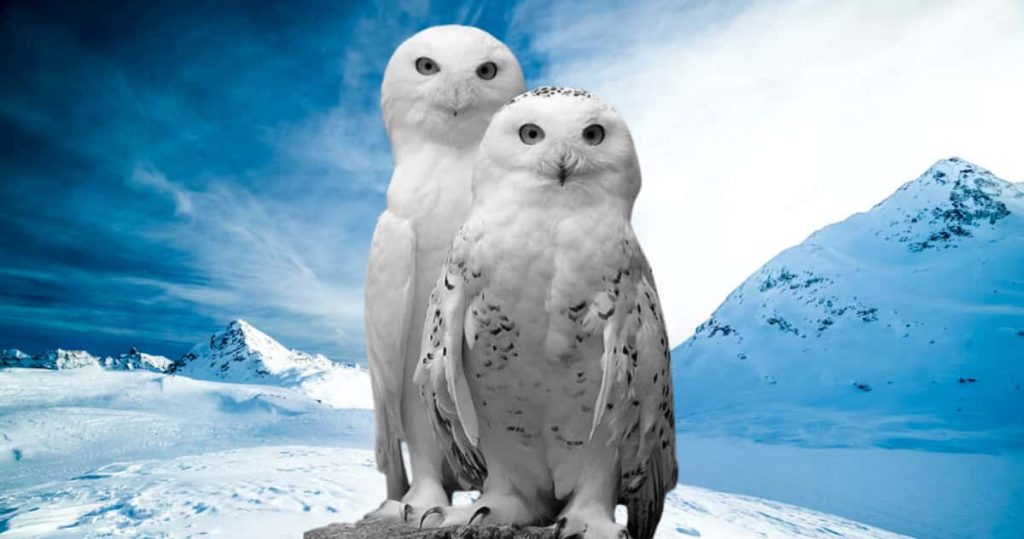
92 percent of bird species are polygamous, and the remaining 8 percent are monogamous. As a bird lover, the question may come to the mind of many: do owls mate for life?
Birds that are best known as lovebirds are those that live with one partner for life. Swans are first on this list. Exotic birds, including pigeons, penguins, California condors, black vultures, and other species, are also present.
Many people have no idea if birds of prey stay with one mate for life. Specifically, do all owl species stay with one mate for life?
Among the world’s 254 owl species, their mating patterns differ somewhat. As a bird lover, I will give you a complete idea about whether all owls mate for life and when the best mating season is for owls.
Contents
- 1 Do all owls mate for life?
- 2 Owls that usually mate for life
- 3 Barn Owl (Tyto alba)
- 4 Northern Saw-whet Owl (Aegolius acadicus)
- 5 Owls that don’t always mate for life
- 6 Barred owl (Strix varia)
- 7 Snowy Owl (Bubo scandiacus)
- 8 Eurasian Eagle-Owl (Bubo bubo)
- 9 Great Gray Owl (Strix nebulosa)
- 10 Spotted Owl (Strix occidentalis)
- 11 Northern Hawk Owl (Surnia ulula)
- 12 Tawny Owl (Strix aluco)
- 13 Ural Owl (Strix uralensis)
- 14 Spectacled Owl (Pulsatrix perspicillata)
- 15 Blakiston’s Fish Owl (Ketupa blakistoni)
- 16 Great Horned Owl (Bubo virginianus)
- 17 Eastern Screech Owl (Megascops asio)
- 18 Western Screech Owl (Megascops kennicottii)
- 19 Burrowing Owl (Athene cunicularia)
- 20 Short-eared Owl (Asio flammeus)
- 21 Long-eared Owl (Asio otus)
- 22 Northern Pygmy Owl (Glaucidium gnoma)
- 23 When do owls mate?
- 24 How do owls mate?
- 25 What happens when an owl’s mate dies?
- 26 Can different kinds of owls mate?
- 27 What species of birds other than owls mate for life?
- 28 FAQs
- 29 Conclusion
Do all owls mate for life?
Owl behavior and mate retention vary by species. The question usually haunts everyone’s mind. The answer is yes. Most of the owls are found to mate for life.
There are several species of owls, and Barn Owls and Northern Saw-whet Owls find contentment in staying together with one partner all their lives. They look for a new one only when the first one dies.
Female northern saw-whet owls, another species of owl, may get separated from their original mates to seek a new partner. One more species, Barn owls, have tendencies to divorce their mates.
Owls that usually mate for life
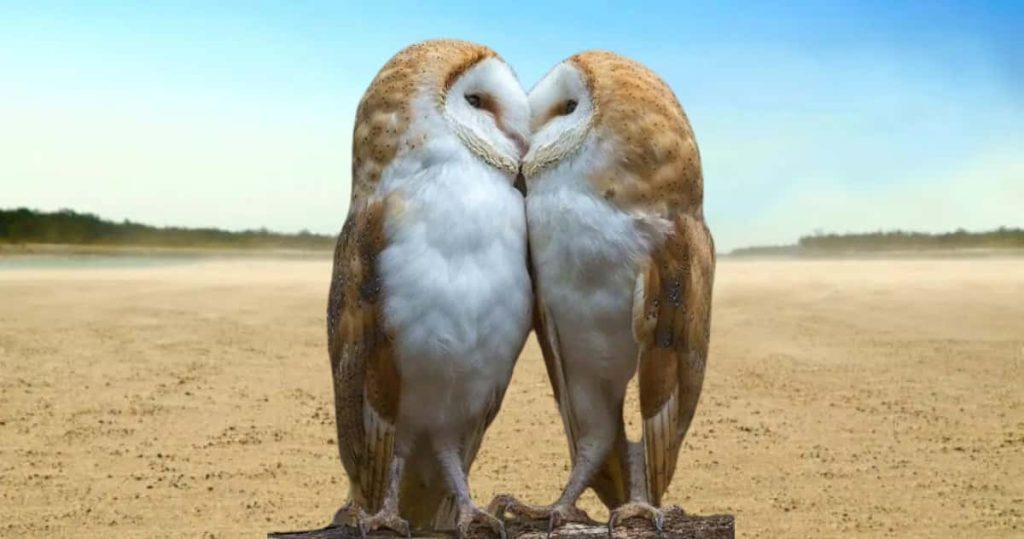
There are very few species of owls that mate for life. Below is a list of some owl names that choose a mate for life:
Barn Owl (Tyto alba)
The Barn Owl is found almost all over the world. Known for its medium build, pale body, heart-shaped face, and ghostly appearance, its way of hunting is exceptional, making it different from other owls.
Barn owls typically nest in tree cavities, abandoned buildings, or man-made nest boxes. Many people have questions: do barn owls mate for life? The answer is yes.
They stay with one partner for life. Nests in one place for years. Lays 4–7 eggs once a year. Both parents incubate and rear the young.
Northern Saw-whet Owl (Aegolius acadicus)
The Northern Saw-whet The owl is specified as a small type that plays a pivotal role in preserving North American ecosystems. They are also known for their looks and unique voices. This owl reaches a length of about 7 to 8 inches with a feather that varies from gray to reddish-brown and a wingspan of about 16 to 18 inches.
Northern Saw-whet Owls are known for their monogamous breeding pairs. They tend to mate for life and show strong bonding. Both parents participate in hatching the eggs and rearing the young.
Owls that don’t always mate for life
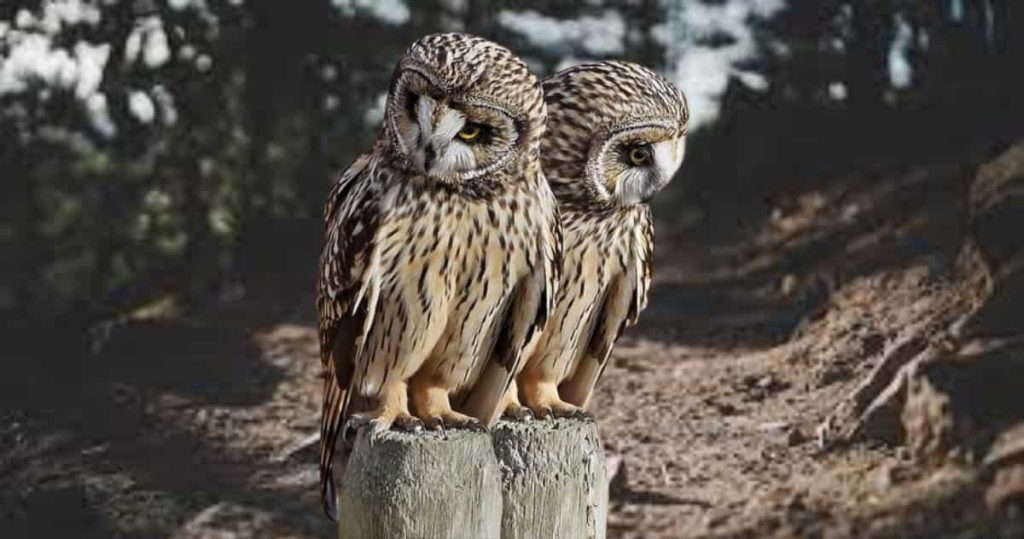
Most of the owl species that do not mate for life—those that come together only during the breeding season—are described with a list of names:
Barred owl (Strix varia)
Barred owls are the species that are spreading widely and adapting to nature. They are visible across North America and identified for their distinctive appearance and unique haunting calls.
This is a medium-sized owl, about 16 to 24 inches in length, with a wingspan of about 38 to 43 inches. They tend to share their responsibility for building nests and parenting. There are vertical stripes on their feather, making a distinctive barred shape.
Barred owls are known to form monogamous pairs during the breeding season. They have collective responsibilities for building nests and parenting.
Snowy Owl (Bubo scandiacus)
The Snowy Owl is specified as a magnificent and iconic type known for its pristine white feathers and adaptability to the arctic environment. Due to the white feathers of this species of owl, this species of owls and this owl feather identification is very easy.
It is a particular species that is large, measuring about 22 to 28 inches in length and having a wingspan of about 4.2 to 4.8 feet. Males are slightly smaller in size. Famous for its attractive appearance.
Snowy owls are not known to form lifelong monogamous pairs. Both raise their children. Once the breeding season is over, snowy owls do not necessarily maintain the same pair bond for the rest of their lives.
Eurasian Eagle-Owl (Bubo bubo)
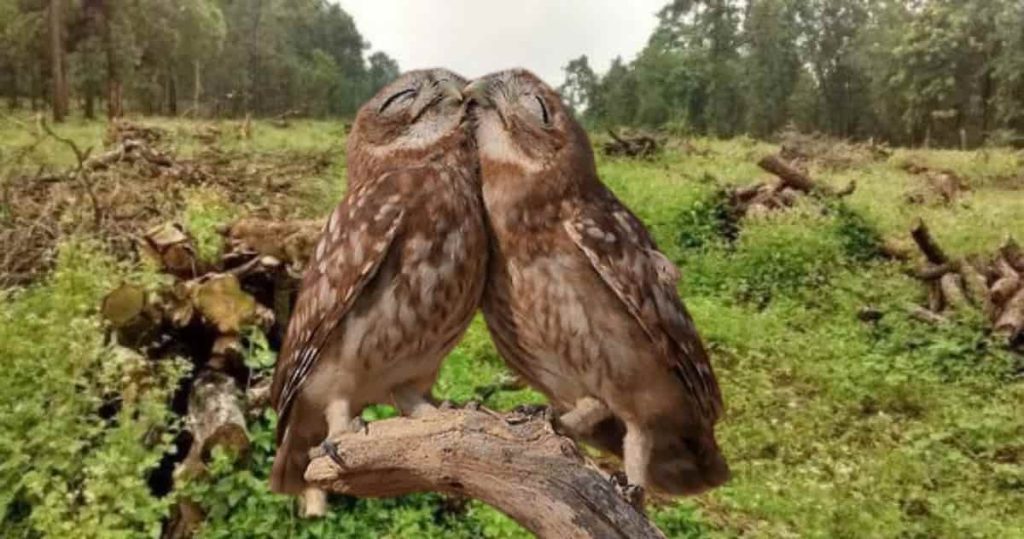
The Eurasian eagle owl belongs to this particular species of owl, which has a majestic and powerful appearance. It’s known to be native to parts of Europe, Asia, and North Africa. Specified for its large size, distinguishable appearance, and strong ability for hunting.
Its wingspan is up to 6.6 feet, and its length is about 24 to 28 inches. The variant color of its plunge helps it mingle with its natural environment.
Eurasian eagle owls do not usually mate for life. They form pair bonds during the breeding season, and they may disband after the breeding season.
Great Gray Owl (Strix nebulosa)
This gigantic owl is best known for its face disc, which can look ghostly. It is normal for a person to be afraid of this species of owl if he suddenly comes face-to-face.
It is specified as one of the largest owl species, with a wingspan of over 5 feet and a length of approximately 24 to 33 inches. They live in boreal forests and woodlands.
Great gray owls do not usually mate for life. As the breeding season arrives, they tend to engage in courtship displays and vocalizations to establish pair bonds for successful breeding. After the breeding season, these bonds dissolve.
Spotted Owl (Strix occidentalis)
The spotted owl has a medium-sized shape and is marked for its striking appearance and association with old-growth forests. The unique pattern of its feather of brown feathers with white spots helps camouflage it in its preferred habitat. It has a length of about 17 to 19 inches and a wingspan of about 42 to 45 inches.
Spotted owls are known to form pair bonds during the breeding season. They get engaged in displaying courtship and vocalizations to create attraction for mates and establish territories. However, like many owl species, their pair bonding is often centered around the breeding season and may not last a lifetime.
Northern Hawk Owl (Surnia ulula)

The Northern Hawk Owl is known to be a unique and striking owl species that displays behavior reminiscent of both owls and hawks. This medium-sized owl exists with a measurement of about 14 to 17 inches in length and a wingspan of about 24 to 27 inches. There is a combination of a light black color on its feather, helping it to blend in with its surroundings.
Northern hawk owls are known to form pair bonds during the breeding season. As with many other owl species, these bonds are often centered around the breeding season and may not last a lifetime.
Tawny Owl (Strix aluco)
The Tawny Owl is a particular species that appears to be charismatic, spreading widely, and known for its distinctive hooting call and adaptable nature to different habitats.
It has a disheveled feather and a haunting voice. As for that, the tawny owl has earned a place in folklore and natural history.
This medium-sized owl is about 14 to 16 inches in length, with a wingspan of about 34 to 39 inches. Its feather has a variation of color from brown to gray, with intricate patterns that provide camouflage.
Tawny owls are known to form monogamous pairs during the breeding season. They tend to engage in courtship displays and vocalizations, and their pair bonds can last for multiple breeding seasons. They tend to share responsibilities while building a nest and parenting.
Ural Owl (Strix uralensis)
The Ural Owl has a fascinating and elusive look, and it’s native to Eurasia. Its size is medium and measures about 20 to 26 inches long, with a wingspan of about 43 to 49 inches. On its feather, there is a mixture of gray, brown, and white markings, providing effective camouflage in its forest habitat.
Ural owls are known to form monogamous pairs during the breeding season. They are seen to engage in courtship displays, vocalizations, and interactions, often leading to the formation of long-term pair bonds. They tend to share responsibilities for building nests and parenting.
Spectacled Owl (Pulsatrix perspicillata)
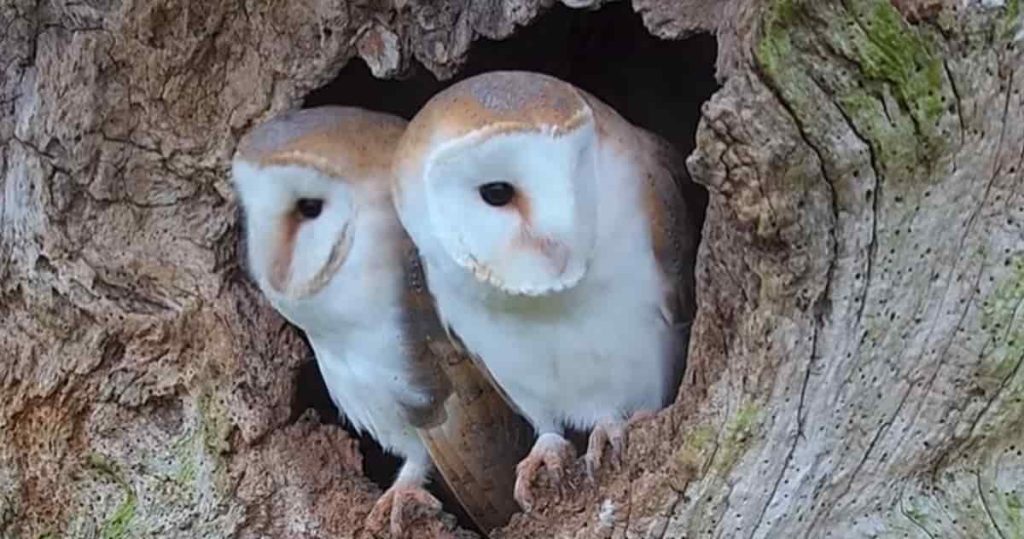
The Spectacled Owl is a fascinating and distinctive owl species, native to Central and South America. It is known for its striking facial patterns and haunting voice.
This medium-sized owl measures about 18 to 20 inches in length, with a wingspan of about 40 to 44 inches. Its most distinctive feature is the bold facial pattern resembling “glasses”, with white eyebrows and dark spots around the eyes.
Spectacled owls are known to form monogamous pairs during the breeding season. They engage in courtship displays, vocalizations, and interactions. They share nest-building and parenting responsibilities.
Blakiston’s Fish Owl (Ketupa blakistoni)
Blakiston’s Fish Owl belongs to the particular species having a majestic and elusive look, native to eastern Russia, China, Japan, and North Korea, and known for its impressive size, specialized diet, and preference for riverine habitats.
Its wingspan is up to 6.6 feet, and it has a length of 24 to 28 inches. The mixture of dark and light markings on its feathers provides effective camouflage in its riparian habitat.
Blakiston’s Fish Owls are known to exhibit strong pair bonds, and it is often believed that they can form monogamous pairs that last for multiple breeding seasons.
Great Horned Owl (Bubo virginianus)
The Great Horned Owl is in the category of a powerful species of owl, native to the Americas, and known for its large size, unique ears, and hunting skills. They usually lay eggs in late winter or early spring.
They make mates by displaying strength, vocalizations, and courtship behavior. However, they are not lifelong monogamists, but many pairs stay together for multiple breeding seasons.
Eastern Screech Owl (Megascops asio)
The Eastern Screech Owl is specified as a small species of owl native to North America. Its length is about 6 to 10 inches, and it has a wingspan of about 18 to 24 inches. The color of their skin is predominantly gray and red, which helps them blend in with tree bark.
Eastern screech owls do not remain in monogamous pairs for life. They may have different partners during different breeding seasons. This species is usually seen to lay 3–7 eggs per year. Both parents are responsible for incubation and feeding.
Western Screech Owl (Megascops kennicottii)
The western screech owl is measured as a small owl species, native to western North America. It has a shape like a compact species, about 8 to 10 inches in length, with a wingspan of about 20 to 24 inches.
The variety of colors on its feathers ranges from gray to reddish-brown. Their feather has a pattern with lines and spots that help them mingle with their surroundings.
Western screech owls do not usually mate for life. They form pairs during the breeding season, and they may return to the same nesting site for successive years but may have different partners. Both parents incubate the eggs and raise their babies.
Burrowing Owl (Athene cunicularia)
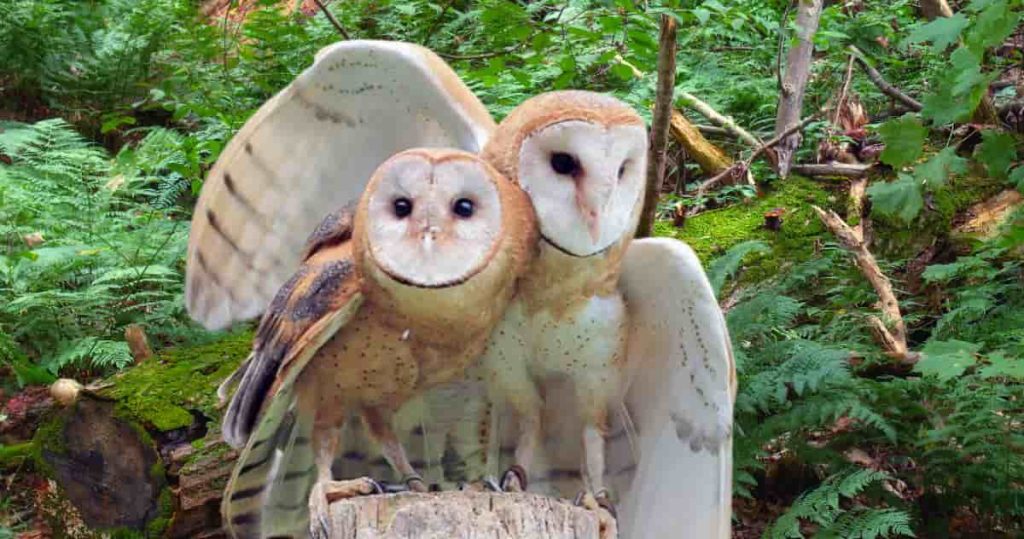
The Burrowing Owl is a particular species that appears to be unique and charismatic, best known for its underground nesting in burrows. The burrowing owl looks like a relatively small owl, about 7 to 10 inches in length, with a wingspan of about 20 to 24 inches. It has a flat facial disc and long legs.
Although burrowing owl species are not strictly monogamous, they are often seen in long-term pair bonds. To raise their young, pairs work together and share the duties of nesting and hunting for food.
Short-eared Owl (Asio flammeus)
The short-eared owl belongs to the category of a medium-sized owl species. Its wingspan is about 38 to 44 inches, and its length is about 13 to 17 inches. This owl is notable for its preference for low-flying hunting. Its feather, which is mottled and streaked, gives it camouflage in the open.
Short-eared owls form temporary pair bonds for breeding and raising their young; they usually do not mate for life. However, once the breeding season is over and the young owls are independent, these pair bonds usually dissolve.
Long-eared Owl (Asio otus)
The long-eared owl is known to be a medium-sized owl species specified for its distinctive long “ear” tufts and cryptic feathers. It is noted for its long tufts of feathers. But these tufts are not real ears but display features. Its length is about 13 to 16 inches, and its wingspan is about 35 to 39 inches.
Long-eared owls do not mate for life. They form pairs during the breeding season, but these bonds are usually temporary and focus on raising their young. Once the breeding season is over, these pair bonds may dissolve.
Northern Pygmy Owl (Glaucidium gnoma)
The Northern Pygmy Owl is specified for its small size, measuring about 6 to 7 inches in length with a wingspan of about 10 to 14 inches. It’s marked for its striking appearance and fierce hunting ability. It looks like a light black color.
Northern pygmy owls are not known to form lifelong monogamous pairs. They usually form pairs during the breeding season, which may only last for that particular period. They look for tree hollows or abandoned woodpecker holes to build nests.
When do owls mate?
It can be observed that the mating season of different owls varies slightly depending on the species. However, the mating season of most owl species is spring, and some species mate in winter.
| Owl Species | Mating season |
| Barn Owl | March through June |
| Great Horned Owl | January through March |
| Eastern Screech Owl | Late winter to early spring. |
| Western Screech Owl | Late winter to early spring. |
| Northern Saw-whet Owl | February through April |
| Barred Owl | Late winter to early spring. |
| Snowy Owl | summer |
| Long-eared Owl | March through April |
| Short-eared Owl | spring and summer. |
| Burrowing Owl | March through June. |
| Spotted Owl | February through April |
| Northern Pygmy Owl | March through April |
| Ferruginous Pygmy Owl | spring |
| Elf Owl | April through June |
| Tawny Owl | November through February. |
| Ural Owl | spring |
| Eurasian Eagle Owl | December through March. |
| African Wood Owl | summer |
| Indian Scops Owl | spring |
| Australian Masked Owl | August through December. |
How do owls mate?
A species keeps its offspring from extinction through mates. The same way applies to owls, nocturnal birds of prey, like all other species.
First, the male owl prepares for mating. He sent various signaling noises to impress the female owl, especially by walking around the female owl’s charipas and offering food to the female owl.
Upon receiving a permission signal from the female owl, the male owl approaches the female owl with a caressing sound, and the male owl establishes rapport by caressing the female owl’s flock.
Later, mating occurs between male and female owls. After that, they remain together for a few weeks. During these few weeks, egg-laying, hatching, and rearing of the young continue.
What happens when an owl’s mate dies?
Owls are social creatures. Most owl species approach each other during the breeding season. Owls are capable of forming strong emotional bonds with their mates. An owl can share responsibilities with its mate. When an owl mate dies, several owl species show signs of mourning.
For days together, they kept calling out to his dead partner. The death of a mate makes it difficult to save their territory. After several days, they start looking for new mates. Once a new mate is found, a new pair is formed.
Can different kinds of owls mate?
In my current era, we see hybrids of every creature. So we may wonder, thinking about whether different species of owls mate or produce offspring through mating. The answer can be said that owls of different species do not usually mate with each other or produce offspring by mating with each other.
Different species of owls are noted for their own unique genetic makeup and reproductive characteristics. Interbreeding two closely related species of owls will result in hybrids. However, hybrids are often not healthy or capable of reproduction.
What species of birds other than owls mate for life?
Gibbons, wolves, beavers, gibbon apes, prairie voles, etc. are several animals that mate for life. Some species of birds other than owls known to mate for life are:
- Swans: Swans are known for lifelong pair bonds.
- Albatrosses: Many species of albatrosses mate throughout their lives.
- Penguins: Several penguin species live in pairs for life.
- Bald Eagles: Bald eagles stay with one mate for life and raise their young.
- Mute Ducks: These ducks are known to stay with one mate.
- Black Vultures: Vultures of this species form stable monogamous pairs.
- Gibson’s Sparrow: They are known for lifelong pair bonding.
- Sandhill Cranes: They are known to form strong monogamous pairs.
- California Condors: These endangered species live in pairs for long periods.
- Gray Crowned Cranes: These cranes are known for their long-lasting pair bonds.
- Sage Grouse: This species of grouse forms monogamous pairs.
FAQs
Q. Do barred owls mate for life?
Ans: They stay together during the breeding season of this species, from December to March.
Q. Do tawny owls mate for life?
Ans: Tawny owls are monogamous from November to February.
Q. Doscreech-owls mate for life?
Ans: Screech owls are monogamous from late winter to early spring.
Q. Do burrowing owls mate for life?
Ans: Burrowing owls are monogamous from March to June.
Conclusion
From the above discussion “Do owls mate for life“, we can conclude that some owls mate for life, while some species of owls only stay together for a few months of the breeding season and separate again after raising their young.
Most small owls have a life span of 5 to 10 years, and larger owl species live 10 to 25 years or more. Owls are confined to their specific territories, so having the same mates helps to save their habitat and territory.
Although several owl species mate for a limited period, lifelong monogamy is not consistent in their behavior. In several species, their pairs break up after 5 to 6 years of being together.